It comes with a pair of jaws, in which one jaw is fixed, and the other one slides to measure the object precisely. The electronically generated reading is displayed on a digital and high-resolution screen. These electrical calipers come with different measuring ranges, materials, and types that serve different functions. With so many digital caliper options in the market, we recommend you consider the following key factors before investing in a digital caliper to get the best one. Measuring Range – The common measuring range of the caliper will be 0 – 6″, 0 – 8″, 0 – 12″ and 0 – 24″. Ensure to select a caliper with proper range that measures your objects. A 6″ caliper is the most common measuring size that balances between measure range and eases to measure/use. A general rule is that caliper with a larger measuring range is a bit difficult to use. Measurement Accuracy – However, the overall accuracy of a caliper is based on the blend of quality & features of the tool and the operating skills of the user.
General-purpose models have a resolution of 0.0005 inches (0.01 mm) that deliver a measurement accuracy of +/- 0.025 mm (or 0.001 inches). Some high-precision models have a resolution of 0.05 mm that delivers nearly accurate measurements.
Material – Stainless steel, carbon fiber, plastic, and composite (a blend of carbon fiber and plastic) are the main materials used to make digital calipers. Among them, stainless steel is the best, durable, strong, corrosion-resistant yet expensive compared to its counterparts. Carbon fiber is an affordable and decent option to use than plastic. We have done a lot of research on various products and finally came with a list of the 7 Best Digital Calipers that are explained well with their best features, pros, and cons. For more information and detailed specifications on digital calipers, we recommend you read our “Buying Guide”.
Best Digital Calipers
7 Best Digital Calipers Reviews
1. Neiko Digital Caliper
You must have heard about Neiko before, as it is a highly popular brand in the market. It has many decent products, including this digital caliper. At the 1st position, we have a highly applicable digital caliper from Neiko. This caliper provides you with 3 measuring modes that are the inches, fraction, and the universal standard millimeters. It has a high range of 0 to 300 mm in length and capable of providing highly accurate results up to 0.02 mm. It is built from stainless steel with a knurled thumb on the dial or easy movement. The digital LCD screen on the front is pretty large in size. Hence, you can easily check the results with great visibility and clear reading accessibility. This caliper runs on LR44 batteries, and you get 1 battery included in the package. You also get an extra replacement for the battery also included in the package. It comes with a customized storage case for better transportation. Best Features:
Highly applicable digital caliper 3 measuring modes High accuracy of 0.02 mm Measure up to 300 mm Stainless steel body with a knurled thumb Metric units as well as inches available The LCD screen on the front is pretty large in size Runs on LR44 batteries 1 battery with 1 extra replacement included Storage case included
Pros:
3 different measuring modes available Measurement range is good
Cons:
Warranty description is not given Accuracy could be better
2. Mitutoyo Digital Caliper
Mitutoyo is probably the most premium brand on our list. They have an advanced digital caliper that we are presenting below. Next, we are putting Mitutoyo 500-196-30 Advanced Onsite Sensor Absolute Scale Digital Caliper as a premium option for long term usage. It has a very high accuracy of 0.01 mm. You can measure up to 150 mm with this caliper that is pretty much standard for digital calipers. The digital screen on the front will display the result in both metric units as well as inches for versatile operation. As you can see in the title, it has an advanced onsite sensor that provides an electromagnetic inductive sensor to avoid dirt, oil, or water for the operation. You will also get a protective case for the caliper to prevent it from any damage while traveling around. There is a 1 year warranty period given by Mitutoyo. Best Features:
Premium option from the list High accuracy of 0.01 mm Measure up to 150 mm Metric units as well as inches available Protective case included 1-year warranty
Pros:
Very accurate digital caliper Advanced onsite sensor is a great feature
Cons:
Very expensive price tag Warranty period is short regarding price tag
3. Vinca Digital Vernier Caliper
Vinca is a renowned brand in the measurement instruments genre. They have a high rated digital caliper in their lineup given below. In the 3rd position, we have a high-quality stainless steel digital caliper from Vinca. It has a great looking finish along with clearly visible digits on the scale. Talking about the range, it can provide resolution for up to 300 mm long objects with an accuracy of 0.04 mm. You will not have to calibrate the digital caliper as it is already calibrated out of the box. It also features an RS232 data transfer port that can be used to store the results directly into your computer while operating. You also get a special VINCA DTCR-03 cable for data transfer included in the package. There is a year of manufacturer’s warranty along with this digital caliper. Best Features:
High-quality digital caliper Stainless steel body Easy to read scale Pre-calibrated digital caliper Accuracy of 0.04 mm Measure up to 300 mm RS232 data transfer port VINCA DTCR-03 cable included 1-year warranty
Pros:
Measurement range is great No calibration required
Cons:
Accuracy could be better Not suitable for industrial applications
4. Igaging Digital Caliper
iGaging is yet another well-known producer of digital instruments. They also produce a great digital caliper that has received highly positive feedback. In the 4th position, we are giving you the most reliable digital caliper available in the market. iGaging ABSOLUTE ORIGIN 0-6″ Digital Electronic Caliper processes a 0.02 mm accuracy that is good enough for a general-purpose caliper. You can use this caliper to measure anything varying up to 150 mm in dimension. It has an IP54 water-resistant rating that includes water droplets as well as dust resistance. It has a pretty sturdy build quality, and it is designed while considering the DIS standard 862 norms as well as ISO certified manufacturing method. You can get a USB cable separately from the market to attach this caliper to your computer. It is backed by 2 years of warranty from iGaging, making it the most reliable option in comparison Best Features:
Most reliable digital caliper High accuracy of 0.02 mm Measure up to 150 mm IP54 water-resistant rating High water droplet as well as dust resistance Great build quality Meets DIS standard 862 norms ISO certified manufacturing USB cable available separately 2-year warranty
Pros:
Warranty period is pretty good Great water and dust resistance available
Cons:
Accuracy could be better USB cable not included in the package
5. Rexbeti Digital Caliper
Rexbeti is a comparatively lesser-known brand on our list. Still, it has a great budget option available. Here, we have a decent looking digital caliper with a pretty competitive price tag. You will get a polished stainless steel finish on the body that gives out a great look. His design is also pretty sleek and good looking. It has 0.02 mm accuracy while measuring objects up to 150 mm. It has an IP54 protection rating available that ensures water as well as dust resistance. As it is more focused on general applications, it can be the best choice if you are looking for a home DIY tool. The LCD display is pretty big and displays quite clear results in inches, metric as well as fractions. The instrument feels a bit heavier in comparison due to its build quality. Hence you expect better control over the slider for precise results. An extra battery is included in the package for long term use. Best Features:
Decent looking digital caliper Polished stainless steel finish Pretty sleek design attribute High accuracy of 0.02 mm Measure up to 150 mm Metric, inches and fraction units available IP54 protection rating available Heavier in weight Extra battery included
Pros:
Great build quality IP54 protection rating for better protection
Cons:
Warranty description is not given Accuracy could be higher
6. M Moock Digital Caliper
Moock is a very affordable brand that produces decent instruments. Fortunately, they have a cheap digital caliper mentioned below. Here is the most affordable option from our list of the best digital calipers. Even though it has a cheaper price tag, it gives a decent stainless steel body that looks pretty stylish. There is an IP54 rating as well to provide reliable insurance against dust and water damage. It is a highly accurate digital caliper, providing an accuracy of 0.01 mm. There is a standard 0 to 150 mm measurement capacity available on this caliper. The digital LCD display on the front is extra large to provide easy to read results. You can set the caliper to work with millimeter, inches, or even fraction units if you require. There is a grooved roller thumb in the lower side of the dial to help you move the jaws swiftly. It has a built-in auto-off feature that will turn off the caliper after 5 minutes of ideal time. There is still a year of warranty available on the caliper considering its minimal price tag. Best Features:
Most affordable option from our list Stainless steel body Stylish design IP54 water and dust protection rating High accuracy of 0.01 mm Measure up to 150 mm Extra-large LCD display Metric, fractions and inches units available Grooved roller thumb Built-in auto-off feature 1-year warranty
Pros:
Auto-off feature can save a lot of battery Very minimal price tag
Cons:
Measurement range can be better Not suitable for industrial applications
7. Clockwise Tools Digital Caliper
In the end, we have a digital caliper from Clockwise Tools. You might not have heard about this name before, but rest assured, it is worth your attention. We will finish our list with Clockwise Tools DCLR-1205 Electronic Digital Caliper. Similar to many other options, it also has an IP54 rating, which is essential if you are planning on more outdoor usage. It is a pretty versatile digital caliper, giving you 3 different units for measurement that are inches, millimeters, and fractions. You can measure up to 300 mm long objects with this caliper while maintaining an accuracy of 0.04 mm. Talking about the look and feel, it looks pretty sophisticated due to its premium design and fine polished stainless steel body. It also has an RS232 data transfer port for data transfer. You will be getting a DTCR-02 cable included in the package so that you don’t have to purchase it separately. Every Clockwise Tools DCLR-1205 Electronic Digital Caliper is pre-calibrated out of the box. It is backed by a 1 year warranty period. Best Features:
IP54 rating present. Versatile digital caliper 3 different units for measurement High accuracy of 0.04 mm Measure up to 300 mm Metric units as well as inches available Premium look Polished stainless steel body RS232 data transfer port DTCR-02 cable included in the package 1-year warranty
Pros:
Highly applicable digital caliper Measurement range is great
Cons:
Accuracy is pretty bad Not applicable for professional use
Buying Guide to Choose the Best Digital Calipers:
As a buyer, you should know comprehensively all about the product, including what factors to consider, how to use it, what it is used for, and some operating tips before making its purchase. So, to provide this essential information on digital calipers, we came with a buying guide. This guide will help you to understand digital calipers and choose your most-suited option by comparing your requirement with the above top-notch models. Let’s get into the details of what factors to consider while shopping for the digital caliper.
1. Measuring Range:
The primary to consider before buying a digital caliper is its measuring range, why because it allows you take measurements properly. So, based on your required measurement range, you have to choose the caliper. The measuring scale of a caliper will start from 0 and can go up to 6 inches (0 – 6″), 8 inches (0 – 8″), 12 inches (0 – 12″), 18 inches (0 – 18″), 24 inches (0 – 24″) and so on. 0 – 6″ is considered the most common measuring size of the caliper, as it maintains a perfect balance of ease of measurement and measuring range. Moreover, it will be more difficult to use a caliper, if it has a large measuring range. For instance, it is a bit difficult to use a caliper with measuring range of 0 – 24″ to measure a hole of 1″ diameter. So, it is less often to notice or use measuring sizes over 6″. Hence, a caliper with 0 – 6″ range will provide an ease of use to take measurements for many things, even measuring larger sizes as well.
2. Material:
Generally, the digital calipers are made from carbon fiber, stainless steel, or plastic, in which each material has its benefits and drawbacks. Here is a detailed explanation that helps you to pick the right one. Stainless Steel – It is strong, durable, and heavy, which makes it the most often used material, especially on high-end digital calipers. Also, it effectively resists dirt, oil, and water. With all these excellent features, the stainless steel calipers are most expensive than their counterparts. Carbon Fiber – It is made of carbon polymer fibers, in which its tightly woven strands will make it strong as steel yet lightweight with moderate durability. Moreover, it won’t be corrosion-resistant than stainless steel, and can quickly deteriorate, if exposed to dirt, UV rays, or water. So, with all these things, this carbon fiber caliper is less expensive than stainless steel calipers. Plastic – The plastic calipers are lightest, less durable, and less expensive compared to other material types. It is rarely used by serious DIYers and professionals. Also, you can find composite calipers, a hybrid combination of carbon fiber and standard plastic. Thus, you can get the best features from these two things like durability of carbon fiber at an affordable price of plastic.
3. Accuracy:
The digital calipers are mainly used to take highly accurate measurements of any object. However, the overall accuracy of digital caliper depends on the blend of individual features, quality of the unit, and the operating skill level of the user. Mostly, the general-purpose calipers come with a resolution of 0.0005 inches (0.0125 mm), which corresponds to the measurement accuracy of + or – 0.001 inches (0.025 mm). Few high-precision models have a resolution of 0.005 mm that gives nearly accurate results. They are expensive and rarely found its usage in general commercial purposes or DIY. However, the electronic components (or certain hardware components) which translates the distance between inside and outside jaws will impact the accuracy levels of a caliper. In this article, you can find devices with accuracy varying from 0.01 mm to 0.04 mm. Usually, polished stainless steel digital calipers offer smooth movement to the measuring jaws. A large textured driving wheel on a caliper will offer extra grip for your fingers to slide/move the jar for making more refined adjustment and thereby taking accurate measurements.
4. IP54 Protection Certificate:
Mostly, an electronic caliper is used indoors, yet sometimes it has to be used in hostile environments like outdoors. If you have to use it outdoors, then prefer to choose models designed to use outdoors by withstanding harsh conditions like rain/water, dust and other debris. For this, you have to check the IP (Ingress Protection) rating of a product, which defines the environmental resilience of its electronic components. The first number after IP indicates the protection level of an item against solids and the second number represents its protection level of moisture resistance. IP 54 is considered as the industry standard for digital calipers. Here, in this IP54 rating, 5 represent resistance over dust, whereas 4 means resistance over water splashes. So, use a digital caliper with an IP 54 rating to protect it from harsh conditions while using outdoors.
5. Calibration Certificates:
Some manufacturers charges extra to sell a caliper with a calibration certificate, which ensures its accuracy. If you skip it, yet want to know the accuracy of the caliper you bought, irrespective of a calibration certificate. Then simply verify its accuracy when you receive the caliper. For this, check this measuring tool against a set of gauge blocks. As a minimum basic thing, you have to verify the zero position before using the gauge.
6. Depth Gauge:
Generally, there are two sets of measuring jaws in calipers used to close and open the scale’s top portion. The third tool is a depth gauge, a small rod that retracts and extends from the end of the caliper bar. It is used to measure the depths of cavities, holes, and other recessions. Even though the depth gauge is useful, yet it is flimsy in low-quality calipers. In case, if depth gauge is a must for you, then make sure it is strong and durable to sustain regular use/wear. For this, carbon fiber and stainless steel-made gauge are the perfect options, while gauge made of composite or plastic materials are not suggested.
7. Outside/Inside Jaws:
The outside and inside jaws are the most often used caliper parts for measuring the dimensions (external jaws for outer diameter and internal jaws for inner dimensions) of the object. These jaws are placed on the opposing sides of the caliper’s main scale, in which inside jaws are smaller compared to outside jaws. Alike depth gauge, turn the thumbwheel to move the jaws till the teeth gets in touch with the item. However, calipers with strong and sturdy outside and inside jaws will consistently provide accurate measurements. So, it is must to check the construction quality of the inside and outside jaws.
8. Measuring Units:
Mostly, the display of digital calipers will show measurements in inches or millimeters, yet a few models read measurements in fractional units as well. Usually, the fractional units are not considered the best or simple way to read measurements. The reason behind this is, the digital displays won’t round and may display results as 53/128″ while measuring something, which is not helpful to present/understand the data easily. The versatility is observed through the available measuring units with the caliper. Hence, you should look for a digital caliper that can easily display all units as per your requirement. Thus, it becomes the best option and you can rest assured that getting results in your required unit.
9. Display Size:
The ease of using the caliper is also depends on its display size, as it let you read the measurements quickly without wasting time. So, a caliper with larger displays will make reading simple and easy. This display will differentiate digital calipers over dial models and most people prefer to use this digital ones, why because it is a bit hard to read the dial and indicator needle on dial calipers.
10. Locking Screw:
Locking screws will lock the measuring jaws effectively to ensure that your measurements are accurate. Also, you can find a position lock feature, which lets you accomplish duplicate measurements. These days, market is flooded with several products having low-quality locking screws. So, beware of those products and check them thoroughly before making your purchase.
11. Length:
There are different caliper models that are available with a wide range of lengths from 4 – 48 inches (or greater). A digital caliper with shorter length of up to 12 inches is easy to maneuver and widely used for various domestic and DIY applications. While a longer caliper is used by professionals and contractors.
12. Zero Button:
This handy feature is used to reset the unit at zero quickly to start with the next measurement. Also, it is used as an on/off switch in various digital caliper models. It is commonly seen in electric calipers as well.
13. LCD Screen:
Most cheaper and low-end models feature small screens which make the user hard to read the measurements. So, invest in a caliper having a large LCD screen to see the measurement/display from a distance.
14. Ease of Use:
Always prefer an easy-to-use digital caliper without any issues or complications in its usage. For this, an electric caliper should possess sensitive wheels, smooth measuring jaw movements, and easy to use interface. Also, it should have easy-to-engage functions and easy-to-switch measuring modes. In case, if a caliper is too complex to use, then simply move on and pick another one.
15. Durability:
All these calipers (most are metal-made) gets damaged easily by water, rust, and other liquids (like cleaning chemicals or oils). Thus, even the best unit turns out to be unreliable and hard to use. So, it is a must to select a set of calipers that are durable and resist most of these common damages, and thereby stay strong for regular usage.
16. Cases:
An essential accessory to keep a digital caliper safe constantly. At times, these precision measuring tools get dropped or knocked off a worktable unexpectedly. Here a case will offer a layer of protection, in which, placing the unit in a case will keep it safe. Most manufacturers like Mitutoyo, Starrett, Brown and Sharpe, and Fowler will offer standard cases with their calipers. Yet cheaper models won’t offer standard cases. So, consider this while shopping for the budget-friendly caliper.
17. Metric Systems:
Some people want their measurements in the imperial system (feet and inches), whereas others need to display in the metric system (centimeters and millimeters). Some parts of the world use one type of measuring system, while others use the second type of measuring system. So, to encounter both types, you have to use a digital caliper that displays both types of measurements (inches and mm). Majority of calipers can display both measurements to improve their versatility. We can find an Inch/MM button on the LCD that switches between these two measuring systems, in which both are printed on the main caliper scale.
18. Battery Life:
Battery life is vital to consider while investing in a digital caliper. A caliper with an auto turn on/off feature will extend the battery life. Usually, the battery life of a digital caliper is measured in terms of months or years. Also, it depends on certain features and the price range of the calipers. For instance, premium or high-end models have longer battery life, while budget-friendly options will offer shorter battery life, and thereby maintain some additional batteries. It’s better to take out the battery when not using the tool to extend the battery life. However, a tool with the best battery life will let you use anything whenever required.
19. Thumb Roller:
The thumbwheel or thumb roller is mainly used to do fine adjustments for reading perfect measurements. A hard-to-roll thumbwheel will leave you in more pain. Similarly, pick a caliper with easy and smooth to glide jaws, if not, it may be a bit hard to move.
20. Readout Complexities:
A basic readout is provided by some digital caliper models to take/note any measurement, while a few high-end models offer an array of display options to their users. The display options include fraction conversions, imperial conversions, and metric readings. As a buyer and user, you have to decide whether or not, these options deliver value in that situation. Millimeters and inches (decimals) are standard measurements on any model but it is less common to display inches with fractions.
21. Maintenance:
Although, a caliper is considered a low-maintenance tool, yet it has to be taken some care and maintenance tips for its proper functioning and longevity. Store the tool in a dry location, as it has electronic components to get damaged when exposed to moisture. Keep the device clean all the time to remove dust or dirt within the components and thereby results in unclear display reading. Several models have a case to deter any damage or dust contamination while not using/storing the tool.
22. Other Features:
There are some add-on extra features that help you to use the caliper with ease. Have a look at them and choose your required features, as per your convenience.
Backlighting –
This backlit display feature is mostly found in high-end or premium calipers, which allows you to read the measurements even in low-light conditions. Even though, it won’t matter a lot for some users, while others find it effective in some particulars, especially those who work routinely in dimly lit or confined spaces. Also, be aware that backlighting will lessen the lifespan of the battery.
Data Transfer –
Though an RS232 port is not an essential requirement, yet it can be an add-on feature to the digital caliper. This port will transfer the measurements/data from the caliper to the computer. Most users won’t prefer this feature, but it is a handy feature for a few applications to record the data straight to the computer.
Repeatability –
You can observe this feature cited in the specifications of a given digital caliper. It is a value that how the measurements are close to each other while measuring the same object numerous times.
USB Output –
With this USB output, the user can transfer the measurement data from the caliper to your computer or other devices directly. This feature is essential to maintain a track of past measurements or simply to make statistics.
Automatic Shutoff –
Usually, these digital calipers run by battery power and have an automatic shutoff function that will extend the battery’s lifespan and make it work for a long time.
23. Reliability:
One has to pay attention to the warranty period given by the manufacturer. The warranty period is a great way to get an idea about the durability of the digital caliper. If the vernier caliper is highly reliable, one has to find a longer warranty period offered by the manufacturer. As the digital calipers are handheld instruments, you need to be very careful with the instrument. Also, there is a high chance of water- or dust-related damage to the digital display. To ensure the reliability of the display, take a closer look at the IP rating given by the manufacturer.
Types:
In general, there are two main types of digital calipers available in the market – general-purpose calipers and specialty calipers. Even though their difference is so subtle that most users won’t consider them, yet you should know about them in detail to choose the right option.
General Purpose Calipers –
Usually, these general-purpose calipers are designed to use for the widespread workshop, which mostly has the same features and specifications as the specialty model. They are not at all certified for accurate measurement that may provide inaccurate results. Also, these units are manufactured with inferior quality materials, which quickly degrade in the harsh work environment.
Specialty Calipers –
This specialty caliper model is developed to take specific types of measurements, like key-slot or pipe thickness measuring. The adjustment will make a huge difference in accuracy compared to their counterpart (general-purpose). However, this accuracy calibration certificate will make the tool ideal for professional use. While the general-purpose unit lack this certification, yet these are not certainly bad. This type of digital caliper is mostly used in light-duty or household workshop projects, where highly accurate measurement is not essential. They save a lot of money even though they deliver accurate results more than vernier or ruler. So, the project requiring high precision is recommended to use a digital caliper with calibration certified.
How to Use a Digital Caliper:
Usually, a digital caliper is a user-friendly device, and one should know how to use them properly. You have to turn on the tool and close the jaws to ensure that it displays zero reading. In case, if it won’t show, then simply press a zero or origin button to reset this scale reading. You can measure the scale readings in three ways. Place an object inside the caliper jaws to know the outside dimensions of the object. While measuring inside measurements (such as machine nut or bushing carrier), close the caliper jaws and put the interior measurement tips found on the caliper’s top, inside the object, and open them far. When measuring an object’s depth like a hole, then put the caliper’s flat end onto the hole’s edge and open the jaws. The measurement thumb emanates out till the hole bottom gets hit, and this is the actual measurement. If there is an over the movement of jaws while taking measurements, then gently tighten the thumbwheel to raise friction. With the help of a small dial on the bottom side of the caliper will let the user roll the jaws rather than just push them with hands. Clean the caliper after use to ensure there is no dust, liquids, or other debris. Since it is a sensitive tool, improper care will make the measurements not useful. Keep it in its case, if the case won’t come with the product, you have to buy it separately.
Tips to Use Digital Caliper Effectively:
The user should know how to use the device properly to get accurate and best results out of it. Here are some basic usage tips mentioned.
Before you start taking the measurement, ensure to reset/zero-out the reading on the LCD screen display. After setting the display to zero, then turn the thumbwheel till both jaws (inside and outside) get in contact with the object. Make sure that outside jaws are parallel to the object sides to maintain firm contact with the object. The inside jaws have to be reset to the sides of the object for the inside diameter. Use a depth gauge for measuring the depth of any groove, object, or recession. Ensure that caliper’s bottom is set perpendicular to the measuring object and slide the thumbwheel till the tip of the gauge bottoms out in the object. To transfer or save the measurement, you have to tighten the locking screw after reading the measurement. It is a must to calibrate your calipers (using a calibration gauge or professionally) once a year to guarantee accurate measurements. If your tool won’t come with this calibration certificate, then ensure to calibrate them after buying. Check the wear and tear signs like burrs or scratches regularly on the scale or jaws, which might affect the accurateness of your measurements.
Conclusion:
A digital caliper can come out as a great replacement for a couple of different tools. Also, as it is a digital instrument, you do not need to doubt it’s accuracy as well as precision. In this article, we have given you a couple of choices for the best digital calipers available for you. You can take a look at these various options and compare them according to your necessity. You can also find a feature-rich buying guide in this article to help you along with your purchase. But, if you are still not sure about your choice, you can consider our recommendations given below:
First, we will recommend M MOOCK Digital Caliper if you are running on a tight budget. Being the cheapest option from our list, MOOCK Digital Caliper is capable of measuring up to 150 mm long objects while maintaining the accuracy up to 0.01 mm. There is 1 year of warranty given by the manufacturer on this caliper. Next up, you should consider buying iGaging Digital Caliper if you are looking for a long-lasting product. You can get a long 2 years of warranty on this caliper, making it the most reliable option on this list. It has a 0 to 150 mm measurement range and processes 0.02 mm accuracy. Lastly, we will suggest VINCA Digital Vernier Caliper is a great value for money option. It is a long-range digital caliper that can measure up to 300 mm with an accuracy of 0.04 mm. You will also get a year of warranty from the manufacturers.
Make sure to share your thoughts in the comments section. You can also post any questions down there if you have any! Comment * Name * Email * Website
Δ



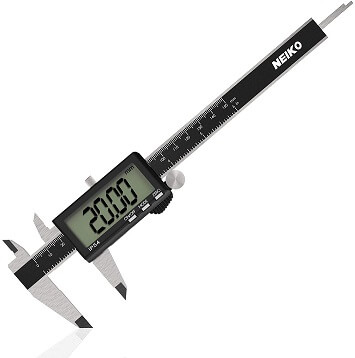
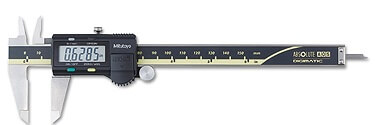
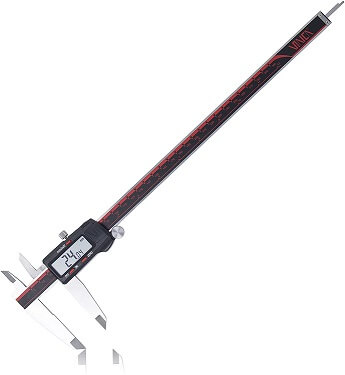
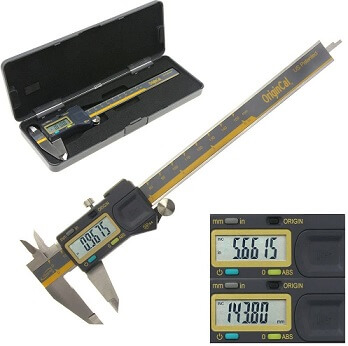
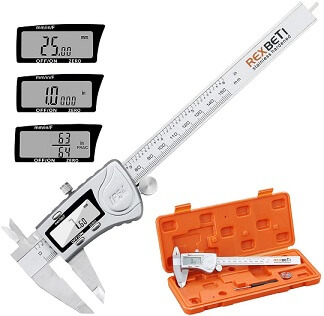
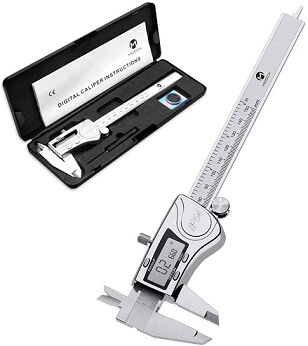
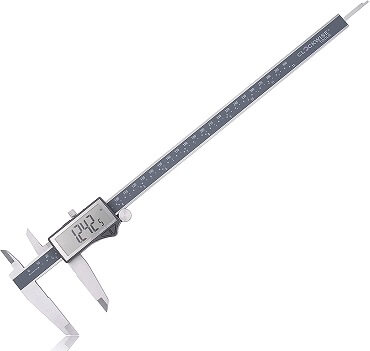


![]()